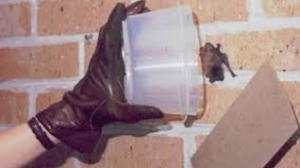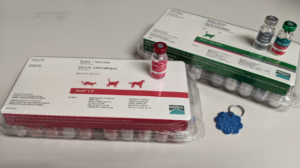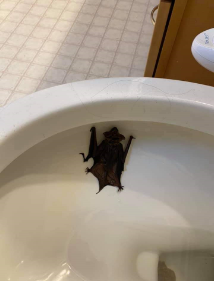Back to Basics – The Rabies Vaccine
Hello again everyone! Let’s talk about one of the most basic, essential parts of veterinary medicine – the rabies vaccine. First of all, let’s start with the rabies virus. The rabies virus is 100% fatal. I repeat, 100% FATAL. This is a very important point and why we don’t mess around with rabies risk and exposure. The virus is usually spread via bite wounds, but any time that saliva or other bodily fluids from an infected animal or human is exposed to a break in the skin of another animal or human there is potential for transmission. I’m including some information from the CDC in the reference list that gives way more detailed information about the virus for those that like full scientific explanations. Once the virus is in a person or animal’s bloodstream, it fuses with cell envelopes to get inside, and then uses the machinery that a cell already has inside of it for normal cellular activity to replicate. Once the cell has made more copies of the virus, the new copies of the virus “bud” out of the cell in little packets that then go on to infect other cells in that person or animal. The virus infects and buds from cells in the salivary glands. The goal of a virus is to get to the next “host” (susceptible person or animal), so the virus has evolved to induce aggression and biting – the perfect way to transmit that virus from the salivary glands to the next host. Eventually, the virus spreads to the brain and causes the cells in the brain to die, leading to the death of the person or animal that the virus is living in.
https://www.cdc.gov/rabies/transmission/body.html
The vast majority of the cases that get reported to the CDC every year are from wild raccoons, skunks, foxes, and bats. Woodchucks can also be infected. We worry about our pets and livestock because these animals can bite them without us knowing it, thereby infecting them with rabies. And remember – this is important for indoor cats and dogs – bats can get into your house! Bat teeth are very tiny, so bites aren’t always seen or felt. Any time a bat is in your house OR you come in contact with one outside, it is important to trap it and, unfortunately, send it out to be tested. Per the CDC, “any animal bitten or scratched by either a wild, carnivorous mammal or a bat that is not available for testing should be regarded as having been exposed to rabies.” Rabies is 100% preventable with the rabies vaccines that we have available, which is why it is important to keep cats, dogs, and ferrets up to date on their rabies vaccine. Small mammals such as squirrels, rats, mice, hamsters, guinea pigs, gerbils, chipmunks, rabbits, and hares are almost never found to be infected with rabies – probably because they are unlikely to survive a bite by a rabid animal. Bites by these animals are not considered a risk for rabies exposure unless the animal was acting sick or behaving unusually in a high-risk rabies area.

Capturing a bat – https://www.fairfieldct.org/Rabies
The state of Connecticut requires that all cats and dogs be up to date on their rabies vaccine. Below is a link to the rabies advisory notice given out when there is possible exposure or a wound of unknown origin:
https://portal.ct.gov/-/media/DOAG/Inspection_Regulation/2017/CTrabiesadvisorynoticeRevised10102017pdf.pdf
What are the practical consequences if a pet is not kept up to date? If an unvaccinated or not up-to-date dog or cat bites a person, Animal Control must get involved and determine the proper steps – usually involving some level of quarantine, sometimes for weeks, away from the owners. This is stressful and traumatic for pets and owners! Sometimes, depending on the case, immediate euthanasia and testing are recommend. Why euthanasia? Because the test for rabies is using fluorescence to look at brain tissue, which is unfortunately not practical for a live animal.

You get a rabies vaccine! You get a rabies vaccine!
Everybody gets a rabies vaccine!!! (and nobody gets rabies)
But Dr. Muir, you might be saying, Fluffy would never bite anybody! If I had a nickel…but seriously, there are situations where even the sweetest of pets may feel the need to bite. Animals that are in pain from injury or illness and animals that are very stressed and fearful can bite. My own late old lady dog bit me once – just once – a number of years ago when she was attacked by another dog in our apartment complex that was not being controlled by her owner, and I foolishly stuck my hand in to try to push the other dog off of her. My dog bit my hand and broke skin – quite accidentally, as she was just trying to defend herself from the other dog – but hey, if she had not been up to date on her rabies vaccine, it would have been a headache. It would have been even MORE of a headache if she hadn’t been up to date and bit the OTHER dog’s owner, and animal control had to get involved.
Cats and dogs who don’t leave the home sometimes get stressed by visitors, and even if it is the visitors who are acting inappropriately, your pet is still YOUR responsibility, and it falls to you if someone gets bitten – even if you feel that that person maybe kind of deserved it. It all gets even more serious if a child is bitten – kids are often not fully trained as to how to act around animals, and they can be loud with jerky movements, so even if they are not trying to be scary to an animal, it can come off that way. If your pet bites anyone other than you, you never know how that person might react, or what their doctor, family members, insurance company, or friends might convince them to do. And post-exposure shots are no joke – we know because every once in a while someone brings in a sickly stray kitten or unhealthy indoor/outdoor cat that during the progression of it’s illness starts showing neurological signs…and a few times these animals that have come here have ended up having rabies, thus exposing our staff and requiring us to get post-exposure shots (as does every family member of the people who own/bring in the cats that have had any interaction with it). It is a risk of the profession, but one that we try very hard to protect ourselves from. Just cover yourself and us and keep your pet vaccinated!

Photo of an unexpected house guest from a (non-GVH) veterinarian’s personal home, trying to find the most cave-like place in the house. (Used with permission).
At Guilford Veterinary Hospital we carry rabies vaccines for cats, dogs, and ferrets. We are happy to booster the rabies whenever there is a bite or wound of unknown origin or a bite from an animal whose vaccine status is not known. Please give us a call if you have any questions about your pet and rabies!
–Dr. Dana Muir
Resources – Rabies in Connecticut:
https://www.wtnh.com/news/rise-in-rabid-animals-in-conn/1068597424
https://portal.ct.gov/DPH/Epidemiology-and-Emerging-Infections/Rabies-Statistics
https://www.fairfieldct.org/Rabies
https://www.newtownbee.com/rabies-danger-very-real-with-newtowns-prolific-wildlife-population
https://pix11.com/2018/05/25/warning-issued-after-ct-man-was-bitten-by-rabid-raccoon/
https://www.nhregister.com/connecticut/article/Connecticut-sees-sharp-drop-in-rabies-testing-of-11311177.php
http://www.ct.gov/doag/lib/doag/state%20vet/2017/Rabies_Mngmt-Wildlife_Exposures_Revised121516.pdf
Additional references:
https://www.cdc.gov/rabies/index.html
https://www.cdc.gov/rabies/transmission/virus.html
https://www.cdc.gov/rabies/diagnosis/index.html

